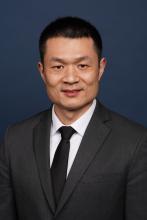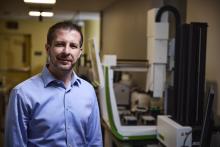Breakthroughs from the Labs of CWRU School of Medicine
Engineering ‘Live’ Replacement Joints
About 500 million people globally suffer from osteoarthritis, a degenerative disease in which joint tissues break down over time. Now, backed by an award from the U.S. Depart- ment of Health and Human Services’ Advanced Research Projects Agency for Health (ARPA-H), a research team led by Case Western Reserve Uni- versity is working to engineer, grow and commercialize “live” replacement joints to treat this debilitating disease.
The contract will be issued in two phases: $20.4 million in the first phase, and, if certain milestones are met, $27.3 million in phase two. Within five years, 40 patients should receive knee replacements with “live” joints, or biocompatible bone and cartilage grown from human cells that can restore nat- ural function to the joint. The project’s goal: to make the treatment available to patients commercially by 2029.
Ozan Akkus, PhD (GRS ’00, mechanical engineering), a professor of mechanical and aerospace engineering at Case School of Engineering and a professor of orthopaedics at the School of Medicine, is leading the multi-institution project, “OMEGA: Orchestrating Multifaceted Engineering for Growing Artificial Joints.”
The CWRU team is a cross-school effort that includes School of Medicine researchers Tracey Bonfield, PhD (GRS ’87, ’91, pathology), associate professor of genetics and genome sciences; Jane Reese Koc (MGT ’08) from the National Center for Regenerative Medicine; James Voos, MD, the Charles H. Herndon, MD, Professor of Orthopaedics; Jacob Calcei, MD, assistant professor of orthopaedics; and Ronald Triolo, PhD, professor of biomedical engineering.
“It is an honor to lead an elite group of scientists and clinicians, integrating their vast expertise to regenerate the knee joint, the most complex joint in the human body,” Akkus said.
Improving Outcomes for Colorectal Cancer Patients
Over the past 50 years, improved treatment methods have helped colorectal cancer survival rates jump from just over 72% to nearly 88%. Thanks to two recent federal grants, Case Western Reserve University School of Medicine researchers aim to improve those statistics even more.
In one study, Zhenghe “John” Wang, PhD, the Dale Cowan–Ruth Goodman Blum Professor of Cancer Research and chair of the Wang Department of Genetics and Genome Sciences, is leading a team looking to further its earlier published findings of an effective treatment for colorectal and, possibly, other cancers.
This team discovered that combining two chemotherapy drugs (CB-839 and 5-FU) stopped the growth of a type of colon cancer in mouse models that involves PIK3CA—a gene that controls cell growth. They credited the success partly on “neutrophil extracellular traps,” or NETs, which trap and kill bacteria.
“We found that patients with tumors that have increased amounts of NETs after the drug treatment survived longer,” John Wang said, and “that certain cancer drugs hijack these neutrophils to kill cancers using extracellular traps. So, our study reveals a new way cancer drugs work, paving the way for the design of new cancer treatments.”
The team’s continued work, funded through a new $2 million grant from the National Institutes of Health’s National Cancer Institute (NCI), could have a broader impact beyond colorectal cancer, he said, because PIK3CA is mutated in about 20% of all human cancers.
In another study—funded through a five-year, $1.84 million grant from the NCI—researchers are studying how a protein involved in colorectal cancer growth, LRG1, functions.
LRG1 is extensively dispersed throughout very small, specific areas of many cancers and contributes to vascular dysfunction. A team led by Rui Wang PhD, assistant professor of surgery, recently discovered that, when secreted Wang from the liver, the protein promotes colon cancer-cell growth—but researchers don’t know why.
By identifying and understanding the precise drivers of cancer cell proliferation and survival, Rui Wang said, “we hope to develop new therapies that can block tumor growth and improve outcomes for patients.”
A ‘Significant Leap Forward’ in MS Research
In less than a year since CWRU founded the Institute for Glial Sciences, its researchers have partnered to create the largest reported collection of stem cell models from multiple sclerosis (MS) patients—and used it to identify ways in which glia (integral support cells in the brain) contribute to the disease.
Using single-cell gene expression profiling, scientists at CWRU and The New York Stem Cell Foundation Research Institute found that stem cell-derived glia cultures from people with primary progressive MS contained fewer oligodendrocytes. Oligodendrocytes produce myelin, the protective sheath around nerve fibers that is lost in MS.
“This observation challenges the conventional understanding of MS as being purely driven by immune system dysfunction, suggesting that the disease may also be fueled by processes originating within the brain itself,” noted Institute Director Paul Tesar, PhD (CWR ’03), the Dr. Donald and Ruth Weber Goodman Professor of Innovative Therapeutics, who co-led the study.
“Our findings represent a significant leap forward in our understanding of MS,” Tesar noted, “and underscore the vast potential in glia as a target for therapeutic intervention that could transform the treatment landscape for many patients.”
A New Approach to Treating Neurodegenerative Disease
Growing evidence indicates astrocytes—the brain’s most abundant cells—can switch from helpful to harmful, leading to increased nerve- cell loss in neurodegenerative dis- eases. So CWRU School of Medicine researchers are working to stop these rogue astrocytes from ever forming.
Led by Paul Tesar, PhD (CWR’03), the Dr. Donald and Ruth Weber Goodman Professor of Innovative Therapeutics, and Benjamin Clayton, PhD, visiting assistant professor of genetics and genome sciences, researchers found that blocking the activity of the HDAC3 protein may prevent the development of dangerous astrocytes and significantly increase the survival of nerve cells in mouse models.
“Therapies for neurodegenerative disease typically target the nerve cells directly,” Tesar said, “but here we asked if fixing the damaging effects of astrocytes could provide therapeutic benefit. Our findings redefine the landscape of neuro- degenerative disease treatment and open the door to a new era of astrocyte-targeting medicines.”
Research Snapshots
The OMEGA grant is among the university’s largest in history. But it’s just one of the many $1 million-plus research grants School of Medicine faculty members have received this year. Here’s a quick overview; look for updates on their findings in future issues of CWRU Medicine:
A $3.5 million National Institutes of Health (NIH) grant to leverage new sequencing technologies to understand how mutations throughout the lifespan may be associated with the risk of aging-related diseases such as cancer. Lead investigator: Jonathan Shoag, MD, associate professor of urology.
A five-year, $2.8 million NIH grant to investigate Sudden Infant Death Syndrome’s causes—and determine possible treatments. Lead investigator: Peter MacFarlane, PhD, associate professor of pediatrics.
A three-year, $1.5 million grant from the Foundation Fighting Blindness to test a possible breakthrough drug that may address retinitis pigmentosa, which causes blindness when photoreceptors in the retina die. Lead investigator: Shigemi Matsuyama, PhD, DVM, associate professor of ophthalmology and visual sciences.





